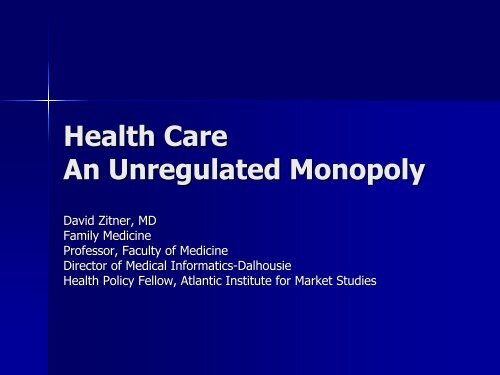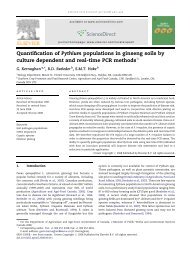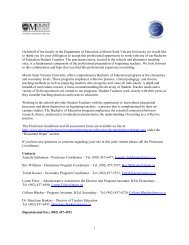Create successful ePaper yourself
Turn your PDF publications into a flip-book with our unique Google optimized e-Paper software.
<strong>Health</strong> <strong>Care</strong><strong>An</strong> <strong>Unregulated</strong> <strong>Monopoly</strong>David Zitner, MDFamily MedicineProfessor, Faculty of MedicineDirector of Medical Informatics-Dalhousie<strong>Health</strong> Policy Fellow, Atlantic Institute for Market Studies
The Problem• Canadians uniformly want a health system thatprovides a broad range of services to rich and pooralike.• We have major problems– Canadian health system is socially irresponsible. It coversa small set of services for rich and poor equally, whileothers including the working poor do not have access tothe full breath of care including expensive drugs.– Workers have few choices when the government healthemployer is irresponsible. No choice between public sectororganizations or between public and private sector– Access problems for rich and poor alike but mainly forthose who are poor, inarticulate and not well connected– Serious problem with health system error
Root Cause of theProblem– <strong>Health</strong> care is an unregulated monopoly notsubject to the same regulatory environment asother industries such as food, automobiles andtransportation. The monopolist is the regulator– Price controls lead to rationing and poor quality• cherry picking for overpriced items such as walk incare,• insufficient supply of more costly services likecomprehensive continuing care
<strong>Health</strong> WorkersDemoralized• Terrible morale among unionized and non-unionizedhealth workers. They can’t t do their job properlyand some are forced to flee to other industries ornon-clinical work.• Demoralized nurses on some hospital units• Family Medicine– Major decline in numbers of family doctors• Government discourages most collaborativepractice. Government won’t t pay and won’t t allowpatients to pay for excellent collaborative services.
Solution• Social economy• Group insurance, through cooperatives forexample for the many items that are notcovered by public health care• Accountability in public health care byseparating government role as an insurerfrom their role as an evaluator and regulator• Choice for health workers
Serious ProblemsNo RegulatoryResponsibility• Access:• Alan Paterson– Deferrable death– Accelerated by inappropriate waiting times– Previous warnings to Board Quality Committee and to<strong>Health</strong> services administrators• Emergency Department– Deaths while waiting in ER. Miscarriage in waiting room– Prolonged Waits• Virtual Destruction of Family Medicine ThroughPrice Controls– $25 per visit and doctor as a private provider pays the fullcost of infrastructure
Uneven Application ofIdeas• Access to services not insured by government isunequal• <strong>Health</strong> worker unions negotiate insurance supportfrom employers (private and public) to pay forprivate services not covered by medicare• Social economy-cooperative cooperative provide lessadvantaged people or those not employed by largeorganizations the opportunity to pool risk to obtainaccess to services not insured by government on apooled risk basis
Medicare Background• Before: People shouldn’t t be deniedcare because they can’t t or won’t t payfor the health care services they need.• Now: People must be denied carebecause their neighbor can’t t or won’tpay for necessary health services (orbecause governments can’t t organizethe system properly)
How Are Canadians HarmedCanada <strong>Health</strong> Act– Accessibility• Emergency Waits, Specialist Consultations, SurgeryCancellations,– Universality• Workers Compensation Board, Different Levels in DifferentDistricts and Provinces. Governments pay for patients (andpractices) in unfair, unequal ways.– Comprehensiveness• Coverage in Canada is Narrow compared to other developedcountries with Universal Insurance (cf. Romanow, Kirby,Definitely Not the Romanow Report). Ear wax removal inNova Scotia
Supreme Court• Unconscionable waits for care violateCanadian’s s rights because ofpreventable death, discomfort anddisability brought about byinappropriate waits
Are Treatments Safe?• In Canada, Baker et al. suggest hospitals are not safe– Baker et al. estimate that 3 in 200 patients admitted to CanadianHospitals are killed because of preventable adverse events.• Adverse events 7.5/100 admissions• Preventable 37.5% 2.8/100 admissions• Deaths 21% 1.5/100 admissions• MUCH GREATER THAN NUMBER REPORTED IN SIMILARUSA STUDIES ALTHOUGH BAKER SUGGESTS THEREPORTING MAY NOT BE COMPARABLEBaker GR, Norton PF, Flintoft V et al.: The Canadian Adverse Events Study: the incidence of adverse events among hospitalpatients in Canada. CMAJ 2004; 170(11): 1678-8686
Carnage?• Baker and Norton– Canadian <strong>Health</strong> <strong>Care</strong> rife with error andresulting carnage– Canadian Patient Safety Institute spends$10 million of your money and has noinformation on whether the error rate isincreasing or decreasing or staying thesame.
From Baker and NortonADVERSE EVENTS WITH Virtually certainevidence of preventability• Acute on chronic renal failure caused byNSAIDs• Acute renal failure with hyperkalemia andintractable constipation with large-bowelobstruction ending in death. Lack of effectof enemas recorded in nurses’ notes andresults of• bowel radiograph not acted upon
Baker Norton EventsCertainEvidence of Preventability• Admission because of severe anemia. Theanemia had been documented in previousadmission but not investigated fully, whichresulted in delayed diagnosis of colorectalcarcinoma• Delirium caused by benzodiazepines givento patient with hepatic encephalopathy• Clostridium difficile colitis following antibiotictherapy. Patient did not receive sufficientvolume expansion, which led to acute renalfailure and death
Certain Evidence ofPreventability• Cardiac valve replacement. Three days before discharge nurse notedwound was red, inflamed and painful, but no treatment or medicalnote. readmitted at 2 weeks with a wound infection,• Nontherapeutic international normalized ratio (INR) on discharge.echogenic mass on prosthetic valve and possible infectiveendocarditis• Chronic renal failure in patient taking sotalol and given increasingdoses of digoxin, which led to increased QT interval, digoxin toxicity,heart block and worsening renal failure• Blood transfusion administered too quickly, which resulted incongestive heart failure and death
Certain Evidence ofPreventability• 8 Delayed diagnosis of rectal cancer in patient with long-standing rectalsymptoms• 9 Delayed diagnosis of uterine cancer in patient with vaginal bleeding for overa year• 10 Delayed treatment of digoxin toxicity in patient with acute renal rfailure,diarrhea and• dementia• 11 Delayed treatment of pseudomembranous colitis• 12 Delirium secondary to aminophylline toxicity. No measurement of druglevel in clinical• context of renal failure• 13 Digoxin toxicity in patient with chronic renal failure possibly contributed todeath• 14 Drug-induced acute urinary retention and postrenal failure• 15 Delirium and vomiting caused by electrolyte imbalance after chemotherapyc• 16 Excessive blood loss during extensive surgery resulted in anemia, whichwas not treated
Certain Evidence ofPreventability• 8 Delayed diagnosis of rectal cancer in patient with long-standing rectalsymptoms• 9 Delayed diagnosis of uterine cancer in patient with vaginal bleeding for overa year• 10 Delayed treatment of digoxin toxicity in patient with acute renal rfailure,diarrhea and• dementia• 11 Delayed treatment of pseudomembranous colitis• 12 Delirium secondary to aminophylline toxicity. No measurement of druglevel in clinical context of renal failure• 13 Digoxin toxicity in patient with chronic renal failure possibly contributed todeath• 14 Drug-induced acute urinary retention and postrenal failure• 15 Delirium and vomiting caused by electrolyte imbalance after chemotherapyc• 16 Excessive blood loss during extensive surgery resulted in anemia, whichwas not treated
Certain Evidence ofPreventability• 8 Delayed diagnosis of rectal cancer in patient with long-standing rectal symptoms• 9 Delayed diagnosis of uterine cancer in patient with vaginal bleeding for over a year• 10 Delayed treatment of digoxin toxicity in patient with acute renal rfailure, diarrhea and• dementia• 11 Delayed treatment of pseudomembranous colitis• 12 Delirium secondary to aminophylline toxicity. No measurement of drug level in clinical• context of renal failure• 13 Digoxin toxicity in patient with chronic renal failure possibly contributed to death• 14 Drug-induced acute urinary retention and postrenal failure• 15 Delirium and vomiting caused by electrolyte imbalance after chemotherapyc• 16 Excessive blood loss during extensive surgery resulted in anemia, which was nottreated
Certain Evidence ofPreventability• 8 Delayed diagnosis of rectal cancer in patient with long-standing rectalsymptoms• 9 Delayed diagnosis of uterine cancer in patient with vaginal bleeding for overa year• 10 Delayed treatment of digoxin toxicity in patient with acute renal rfailure,diarrhea and• dementia• 11 Delayed treatment of pseudomembranous colitis• 12 Delirium secondary to aminophylline toxicity. No measurement of druglevel in clinical• context of renal failure• 13 Digoxin toxicity in patient with chronic renal failure possibly contributed todeath• 14 Drug-induced acute urinary retention and postrenal failure• 15 Delirium and vomiting caused by electrolyte imbalance after chemotherapyc• 16 Excessive blood loss during extensive surgery resulted in anemia, whichwas not treated
Certain Evidence ofPreventability• 17 Failure to follow protocol in management of acute ST-segment elevation myocardial• infarction (MI). Patient readmitted after third MI 1 month after index admission• 18 Multiple readmissions owing to failure to perform endoscopy or find source of gastrointestinal• bleed before discharge• 19 Transfer to intensive care unit (ICU) delayed because of failure to recognize and address the• critical nature of the patient’s s illness. Respiratory failure led to death• 20 Cirrhosis of the liver caused by hepatitis C transmission from m transfusion• 21 Inadequate investigation and post-discharge follow-up in patient with severe acute• pancreatitis and probable pseudocyst• 22 Recurrent infection and need for secondary surgery because of incomplete removal of• nonfunctioning artificial uretheral sphincter• 23 Patient with malignant coronary artery disease referred for urgent ucardiovascular surgery.• Treatment delayed 3 months because of misplaced films at cardiovascular ascular case conference• 24 MI following delayed transfer of patient with unstable angina because referral hospital beds• were unavailable• 25 Misdiagnosis for over 1 year and resulting drug therapy without adequate monitoring led to• delirium and multiple admissions because of falls• 26 Missed diagnosis of anemia associated with recurrent gastrointestinal testinal bleed. Appropriate• blood work not done and patient inappropriately discharged• 27 Normal blood pressure and no hypovolemia, while chest radiograph aph showed pulmonary• edema. Patient given 2100 mL of normal saline intravenously over 48 hours; when saline• stopped and furosemide given, confusion and dyspnea cleared• 28 NSAIDs in context of chronic renal failure and coumadin with lack of proper monitoring• resulted in digoxin toxicity and hypercoagulability• 29 Ovaries removed during hysterectomy; consent indicated that patient punderstood they would• be left
DM COMMITTMENT 1994“WHEN LESS IS BETTER”• Timely access must be guaranteed andinformation about waiting times madepublic.• Quality of care will be ensured byongoing monitoring and publication ofoutcomes as changes areimplemented.
Canadian <strong>Health</strong> <strong>Care</strong>Single Tier for Price, Multi-tier tier forQuality• Canada’s s <strong>Health</strong> System Functions as aSingle Tier for Price with Different Levels ofQuality – Not What Canadians Expect• New Glasgow – A tale of two practices– Shouldn’t t people be permitted to pay to get careequal to their neighbors?– Beyond Face to Face Visits• Avoiding the rationing and inefficiency imposed in ourcurrent health care system.
Public Administration:<strong>Health</strong> <strong>Care</strong> an <strong>Unregulated</strong><strong>Monopoly</strong>• N.S. <strong>Health</strong> Authorities Act: Section 19“The objects of a district health authority are togovern, plan, manage, monitor, evaluate anddeliver health services”• Public Administrators focus, as would any othermonopoly on maintaining their monopoly andavoiding competition• CMA reply to Supreme Court Decision– Privatization if Necessary but Not NecessarilyPrivatization. No one wants to pay for ideologicalreasons only
Public Participation• Self Respect:Tommy Douglas• On October 13, 1961, in a special session of theSaskatchewan legislature, then Saskatchewanpremier, and the man known as the “Father ofCanadian medicare,” T. C. Douglas, said:“I I think there is a value in having every family andevery individual make some individual contribution[to the cost of their coverage under medicare. Ithink it has psychological value. I think it keeps thepublic aware of the cost and gives the people asense of personal responsibility.”
Social Economy• Direct government resources to those who needthem.• Broaden insurance coverage– Drugs and other necessities of modern health care• Have a deductible for government insured services• Encourage communities to become self sufficient toprovide for themselves the services not covered bygovernments and direct subsidies to those whoneed them most
















